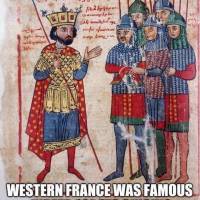
Medieval poets love to describe the beauty of women in their stories. Their hyperbole has no limits – they claim left and right that the maiden in the story you’re hearing right now has the best nose, mouth and eyes ever formed by God!
Wait a second, didn’t Enide possess those one-of-a-kind physical features? It’s beginning to look like there’s a Venus on the half shell in every town in Brittany!
This installment of Girls on Parchment comes from Chaucer’s Tale of Sir Thopas. It is one of the shortest Canterbury Tales – measuring at 241 and… err…1/2 lines. It could have been the longest Canterbury Tale ever – had the host Harry Bailey not made Chaucer stop telling it.
The Tale of Sir Thopas is about a knight who quests after the woman of his dreams, an elf-queen. To win her, he must run from an evil giant knight and make his way through the wild jungle of “the contree of Fairye” – while occasionally making pit stops at his castle to enjoy dainty cakes and model new designer sets of armor. After all, he must look his best on his quest! He’s undeniably the blueprint for Monty Python’s Sir Robin.

Sir Robin (played by Eric Idle) from Monty Python and the Holy Grail image copyright 1974 Python (Monty) Pictures / Sony Pictures
And now, “Liseth lordes, in good entent!”
– Oh, and make sure you always sing Chaucer’s Tale of Sir Thopas to the tune of Bob Dylan’s “The Times they are a-changin'” –
here is Chaucer’s description of our tale’s hero:
Sir Thopas wax a doghty swayn,
Whit was his face as payndemayn,
Hise lippes rede as rose;
His rode is lyk scarlet in grayn,
And I yow telle, in good certayn,
He hadde a semely nose.
His heer, his berd, was lyk saffroun (ll. 1914-20)[1]

Saffron for sale at Philadelphia’s Reading Terminal Market.
This brave knight has a beard like saffron – a soft, yet bristly beard with a complex red aroma. That’s certainly more intimate detail of a knight’s physical features than we usually get in medieval poetry – except for Chaucer’s Squire of course.[2]
Sure, we get endless descriptions of the quality of a knight’s gear, but as far as detailed descriptions of physical features go – the English medieval poet might give us, “he was passing fair” – if we’re lucky – as Malory did for Galahad:
| … therin came twelue nonnes that broughte with hem Galahad the whiche was passynge fayre and wel made that vnneth in the world men myghte not fynde his matche…[3] | … therin came twelve nuns that brought with them Galahad, the which was passing fair and well made, that unnethe in the world men might not find his match…[4] |
But let’s return to Chaucer’s description of Sir Thopas. It continues to describe his outfit – how fashionable and expensive it is:
Hise shoon of Cordewane.
Of Brugges were his hosen broun,
His robe was of syklatoun,
That coste many a jane. (ll.1922-25)
Of clooth of lake, fyn and cleere,
A breech, and eek a sherte (ll.2048-49)
…a fyn hawberk,
Was al ywroght of Jewes werk (ll.2053-54)
His swerdes shethe of yvory (l.2066)
It really goes on and on… shoes made of Cordovan leather, brown socks imported from Belgium. If it was written today, we would need the September issue of Vogue just to follow it.
Chaucer pays tribute to the masters of French Romance by emulating how they describe luxury clothing and character dwellings in such a way that they seem incredibly expensive, even to an audience of court nobility.
He emulates the style of Chrétien de Troyes and Marie de France, but does it so well that he doesn’t realize he’s filling his fantasy balloon with so much air that it will burst.[5]
Enough about Thopas. What about the maiden? Our girl on parchment – how beautiful is she? Well, the only description we get of her is, “elf-queen.” That’s it. “Elf-queen.” Not even, “beautiful elf-queen with ears like sweet pointed peppers.”
We get a longer description of the gingerbread cake that was baking at the court of Sir Thopas:
And gyngebreed that was ful fyn,
And lycorys, and eek comyn,
With sugre that is so trye
The host makes Chaucer end this train wreck of a tale before the elf-queen actually appears in the story. Though we’ll never know how Chaucer’s pilgrim would have described the elf-queen’s supreme beauty, at least The Tale of Sir Thopas provides a different sort of girl on parchment.
“That’s enough music for now, lads!”
Click here for another installment of Girls on Parchment
[1] References to Chaucer in Middle English are taken from Chaucer’s Major Poetry, Ed. Albert C. Baugh (New York, 1963).
[2] Sir Thopas resembles the Squire more than the Knight in The Canterbury Tales. I wonder if Chaucer had originally intended the Squire to tell this tale. Also, I wonder how common stories and jokes about “Runway Knights” who could pass as Zoolander were in Chaucer’s day.
[3] Caxton’s Malory in Middle English from Middle English Compendium (Ch. 13, leaf 307r) available online: http://name.umdl.umich.edu/MaloryWks2
[4] Caxton’s Malory in modernized English spelling from Le Morte D’Arthur, Ed. Elizabeth J. Bryan (New York, 1999), p. 656
[5] Is it purely the English making fun of French style? As always, Chaucer gives his work plenty of layers of comedy. On the surface the poem seems simple enough, but it has an absurdly complex structure that is just waiting to topple over itself like a lost game of Jenga. Though the rhymes technically work, they keep surpassing themselves in their corniness. The cringing audience is forced to take action as a barkeeper would do to stop an absolutely terrible karaoke singer 3 minutes into Don McClean’s “American Pie.” For a few laughs from the scribes at Hengwrt and Ellesmere, see Maik Hildebrandt‘s The Layout of “Sir Thopas” http://maikhildebrandt.wordpress.com/2012/10/19/the-layout-of-sir-thopas/
Update July 28, 2013: Consider King Horn, Havelock the Dane, and other 13th century Middle English Romances in addition to or instead of the French Romances. Chaucer may be parodying English Romance specifically and contributing to its popularity by virtue of his parody. After all, it has been argued that “the spirit of English Romance became the spirit of English literature.” It’s also been argued that Chaucer’s parody of English Romance in Sir Thopas is not restricted to the romance lyric or the minstrel style, but “oral performances of all kinds.” Another good article to help us appreciate the reception and physical form of Sir Thopas is: Jessica Brantley, “Reading the Forms of Sir Thopas“, Chaucer Review 47 (2013): 416-38.











